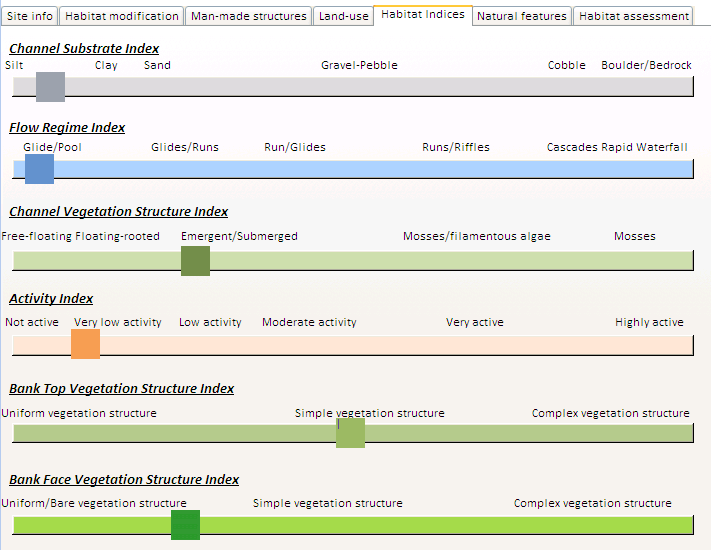Habitat indices
Information on natural habitat features such as channel substrate, flow regime (e.g. riffles, glides and pools), channel vegetation structure, activity (i.e. erosion and deposition features) and bank vegetation structure (from bare to complex) have been summarised into 6 indices presented on sliding scales representing the main environmental gradients encountered in natural settings (see River reach definition).
Each scale is labelled according to the feature(s) dominating at key points along its gradient. For example, the Channel Substrate Index represents a gradient between sites dominated by fine substrate on the left of the scale (silt, clay and sand) to sites dominated by coarser substrates (cobbles and boulders). This gradient represents the typical transition between headwater - upland and lowland streams. Similarly, the Flow Regime Index represents a gradient between sites dominated by slow-flowing features (glides and pool) towards sites dominated by faster-flowing habitats such as riffles and rapids.
The 6 scales enable a quick visual assessment of the character of the reach. The values displayed are the average value of the RHS sites on the selected reach.
For each scale, a marker indicates the location of the reach on the scale. In our case we can quickly assess that our reach is dominated by silt substrate and has slow-flowing features, emergent/submerged channel vegetation and uniform/simple bank vegetation structure. The reach displays very low levels of activity (erosion or deposition).
Combined with previous data on habitat modification and land use, these indices give us some insights into the potential impacts of engineering structures and land management on river habitats.
Channel and bank resectioning are generally associated with an increase in channel depth and width resulting in slower flow types and lower levels of activity. Trees are also removed to let machinery access the channel to perform the work. Banks are regularly mowed and trees are cut down to reduce frictions and potential flooding risks. It is possible that the silt and low flow velocities observed are the direct impact of bank and channel resectioning. Channel vegetation and bank vegetation structure could also be affected by the modifications as vegetation is related to flow, and trees and bank vegetation structure will be affected by the management regime (mowing, tree cutting etc). The lack of signs of activity and presence of deposition or erosion features can also potentially be related to channel resectioning as most features would have been removed in the process of regrading the channel.
